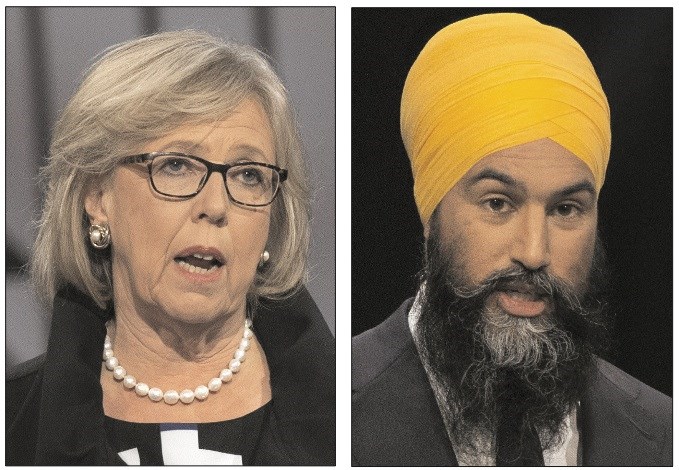If current opinion polls prove accurate (and that’s a big “if”), we could headed for a minority government come Oct. 21. As things stand, although the Liberals and Conservatives are tied in the polls, there’s a slightly higher likelihood that Justin Trudeau rather than Andrew Scheer would head such an administration. The Tories are putting up huge numbers on the prairies, however not enough in vote-rich provinces such as Quebec.
But if a Liberal minority government is in the cards, how might such an arrangement work? I can’t imagine the Grits would seek support from the Bloc Québécois.
Assuming Maxime Bernier and his ridiculous People’s Party of Canada get the shellacking they deserve, there are only two options left — a Liberal/NDP alliance, or a Liberal/Green get-together.
Yet could either succeed? For a start, Elizabeth May, the Green leader, has declared she would not prop up any minority government that supports pipelines. That would seem to rule out working with either the Grits or Tories.
For his part, NDP Leader Jagmeet Singh has said he would permit provinces to block the construction of pipelines across their borders. Here too we have a sticking point that would make an alliance difficult to form.
There is, however, a far larger obstacle to any such arrangement. In their election platform, the Liberals are promising (threatening would be a better word) deficits in excess of $20 billion every year for four years.
This in itself should render the Grits unelectable. There is no conceivable justification for such fiscal profligacy.
However, it pales in comparison with what the Greens and the NDP have in mind.
The Green package calls for $74 billion in new expenditures next year, including $16 billion for free post-secondary tuition and student debt forgiveness, $26.7 billion for free pharmacare, $3 billion for free dental care for low-income Canadians, and much more besides.
This is supposedly offset, to a degree, by huge tax increases. But scant few of them are viable. For example, no Liberal government (or Tory) would hike the corporate tax rate from 15 per cent to 21, as the Greens are proposing.
But even if the tax hikes were carried through, by their own accounting the Green program still results in a whopping $41-billion deficit next year.
Now in a coalition government, you can’t add all of that to the Liberal splurge and come up with a deficit of $61 billion. There is some overlap between the two platforms. But a rough estimate of a Liberal/Green marriage would be a deficit in the $45-billion range, a.k.a. fiscal suicide.
The NDP manifesto is even more amped up. I don’t have a detailed estimate for the deficit they would run, but it has to be at least $50 billion.
In short, neither of these platforms could be embraced to any serious extent by either the Liberals or Conservatives. Yes, some of the wilder stuff could be toned down a bit.
But the signature commitments May and Singh have promised render any sustainable alliance virtually unworkable unless, lured by office, they renege on those promises, which seems political undoable.
It’s worth asking how this mess came about. When the NDP were formed in 1961, the party rapidly became the originator of new social programs, even though it never held office.
This happened because, as the NDP proposed schemes that quickly gained public support, the governing parties quietly adopted them as their own.
Yet this birthing process only worked because a policy vacuum had grown up. What few ideas the Grits and Tories floated were far inferior, in imagination and timeliness, to the NDP’s campaign for social justice. There was a genuine void to fill.
But now consider the current political landscape. Today’s Liberal party has moved so far left it virtually overlaps traditional NDP or Green ideology.
The Tories haven’t moved quite as far, but they too have narrowed the distance between their platform, and longstanding NDP turf. In practical terms, the policy void that once existed is gone.
It’s true both the Greens and NDP have captured the heart and soul of many young people. But they have done so by embracing radical notions that place them far outside the mainstream.
That, I think, is why we find ourselves in a position where parties that should be the conscience of the country are in danger of becoming a lunatic fringe.



